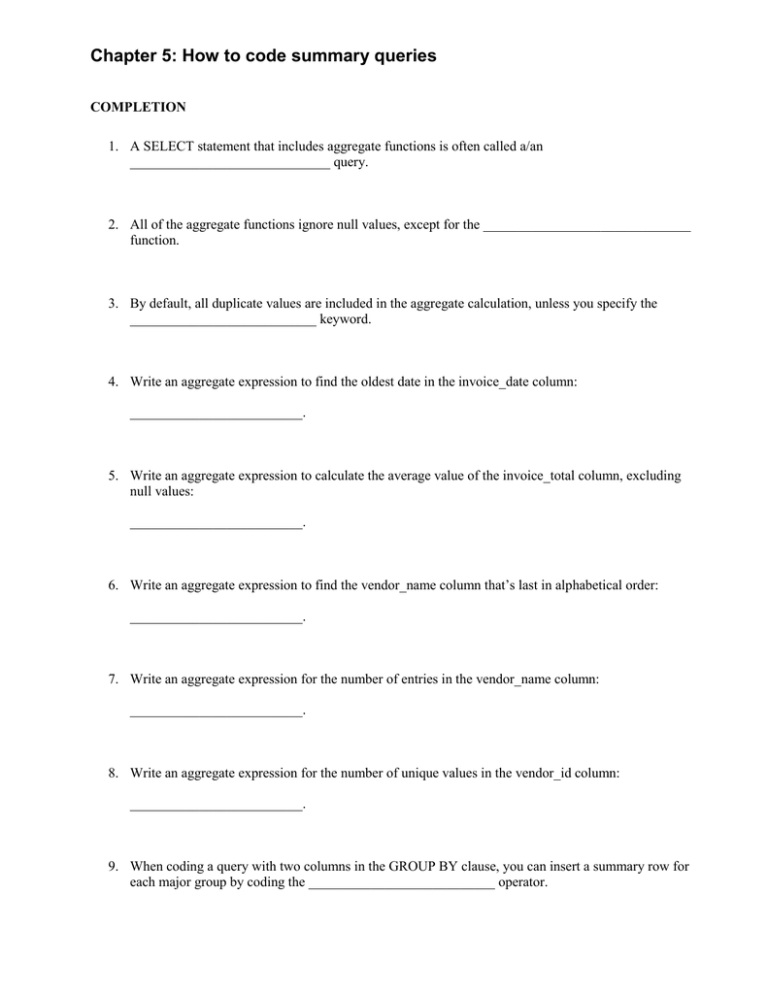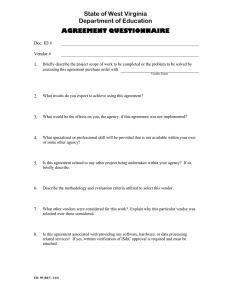Chapter 5: How to code summary queries
advertisement

Chapter 5: How to code summary queries COMPLETION 1. A SELECT statement that includes aggregate functions is often called a/an _____________________________ query. 2. All of the aggregate functions ignore null values, except for the ______________________________ function. 3. By default, all duplicate values are included in the aggregate calculation, unless you specify the ___________________________ keyword. 4. Write an aggregate expression to find the oldest date in the invoice_date column: _________________________. 5. Write an aggregate expression to calculate the average value of the invoice_total column, excluding null values: _________________________. 6. Write an aggregate expression to find the vendor_name column that’s last in alphabetical order: _________________________. 7. Write an aggregate expression for the number of entries in the vendor_name column: _________________________. 8. Write an aggregate expression for the number of unique values in the vendor_id column: _________________________. 9. When coding a query with two columns in the GROUP BY clause, you can insert a summary row for each major group by coding the ___________________________ operator. MULTIPLE CHOICE 1. The six clauses of the SELECT statement must be coded in the following order: a. b. c. d. SELECT, SELECT, SELECT, SELECT, FROM, FROM, FROM, FROM, GROUP BY, HAVING, WHERE, ORDER BY WHERE, ORDER BY, GROUP BY, HAVING WHERE, GROUP BY, HAVING, ORDER BY ORDER BY, WHERE, GROUP BY, HAVING 2. Expressions coded in the HAVING clause a. b. c. d. can use either aggregate search conditions or non-aggregate search conditions can use aggregate search conditions but can’t use non-aggregate search conditions can use non-aggregate search conditions but can’t use aggregate search conditions can refer to any column in the base tables 3. Expressions coded in the WHERE clause a. b. c. d. can use either aggregate search conditions or non-aggregate search conditions can use aggregate search conditions but can’t use non-aggregate search conditions can use non-aggregate search conditions but can’t use aggregate search conditions must refer to columns in the SELECT clause 4. Which of the statements below best describes the result set returned by this SELECT statement? SELECT vendor_id, SUM(invoice_total - payment_total - credit_total) AS column-2 FROM invoices WHERE invoice_total - payment_total - credit_total > 0 GROUP BY vendor_id a. b. c. d. The unpaid balance for each invoice The total unpaid balance due for each vendor_id The total amount invoiced by each vendor_id The total of paid invoices for each vendor_id 5. Which of the statements below best describes the result set returned by this SELECT statement? SELECT vendor_state, COUNT(*) AS column_2 FROM vendors GROUP BY vendor_state HAVING COUNT(*) > 1 a. b. c. d. The names of the vendors in each state The duplicate vendors from each state The number of vendors in each state The number of vendors in each state that has more than one vendor Code example 5-1 SELECT vendor_state, vendor_city, vendor_name, COUNT(*) AS invoice_qty, SUM(invoice_total) AS invoice_average FROM invoices JOIN vendors ON invoices.vendor_id = vendors.vendor_id WHERE vendor_state < 'e' GROUP BY vendor_state, vendor_city, vendor_name HAVING SUM(invoice_total) > 500 ORDER BY vendor_state, vendor_city, vendor_name 6. (Please refer to code example 5-1.) When this summary query is executed, the result set will contain one summary row for a. each city with invoice totals over $500 c. each city with invoice average over $500 b. each vendor with invoice totals over $500 d. each vendor with invoice average over $500 7. (Please refer to code example 5-1.) Although this query runs as coded, it contains this logical error: a. The condition in the WHERE clause should be coded in the HAVING clause. b. The column name for the fifth column in the result set doesn’t match the data. c. The three columns in the ORDER BY clause should use the DESC keyword so the city totals will be in the right sequence. d. The condition in the HAVING clause should be coded in the WHERE clause.

